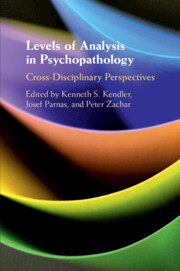Book contents
- Levels of Analysis in Psychopathology
- Advance Praise for Levels of Analysis in Psychopathology
- Levels of Analysis in Psychopathology
- Copyright page
- Contents
- Figures
- Tables
- Contributors
- Preface
- General Introduction
- Part I Neuroscience, Mechanisms, and RDoC
- Part II Phenomenology, Biological Psychology, and the Mind–Body Problem
- Part III Taxonomy, Integration, and Multiple Levels of Explanation
- Section 8
- Section 9
- Section 10
- Section 11
- Section 12
- Section 13
- 37 Introduction
- 38 The Impact of Faculty Psychology and Theories of Psychological Causation on the Origins of Modern Psychiatric Nosology
- 39 Commentary on “The Impact of Faculty Psychology and Theories of Psychological Causation on the Origins of Modern Psychiatric Nosology”
- Section 14
- Section 15
- Index
- References
37 - Introduction
from Section 13
Published online by Cambridge University Press: 02 April 2020
- Levels of Analysis in Psychopathology
- Advance Praise for Levels of Analysis in Psychopathology
- Levels of Analysis in Psychopathology
- Copyright page
- Contents
- Figures
- Tables
- Contributors
- Preface
- General Introduction
- Part I Neuroscience, Mechanisms, and RDoC
- Part II Phenomenology, Biological Psychology, and the Mind–Body Problem
- Part III Taxonomy, Integration, and Multiple Levels of Explanation
- Section 8
- Section 9
- Section 10
- Section 11
- Section 12
- Section 13
- 37 Introduction
- 38 The Impact of Faculty Psychology and Theories of Psychological Causation on the Origins of Modern Psychiatric Nosology
- 39 Commentary on “The Impact of Faculty Psychology and Theories of Psychological Causation on the Origins of Modern Psychiatric Nosology”
- Section 14
- Section 15
- Index
- References
Summary
One of the defining claims of so-called post-positivist approaches to the philosophy of science is that observation is theory-laden (Hanson, 1958; Kuhn, 1962). According to the strongest versions of this claim, theories do not just influence what we attend to, they actually influence what we observe – and people with different theoretical frameworks can look at the same stimuli, but observe different things. If correct, this undermines the notion that there is something called raw observation.
- Type
- Chapter
- Information
- Levels of Analysis in PsychopathologyCross-Disciplinary Perspectives, pp. 459 - 461Publisher: Cambridge University PressPrint publication year: 2020



